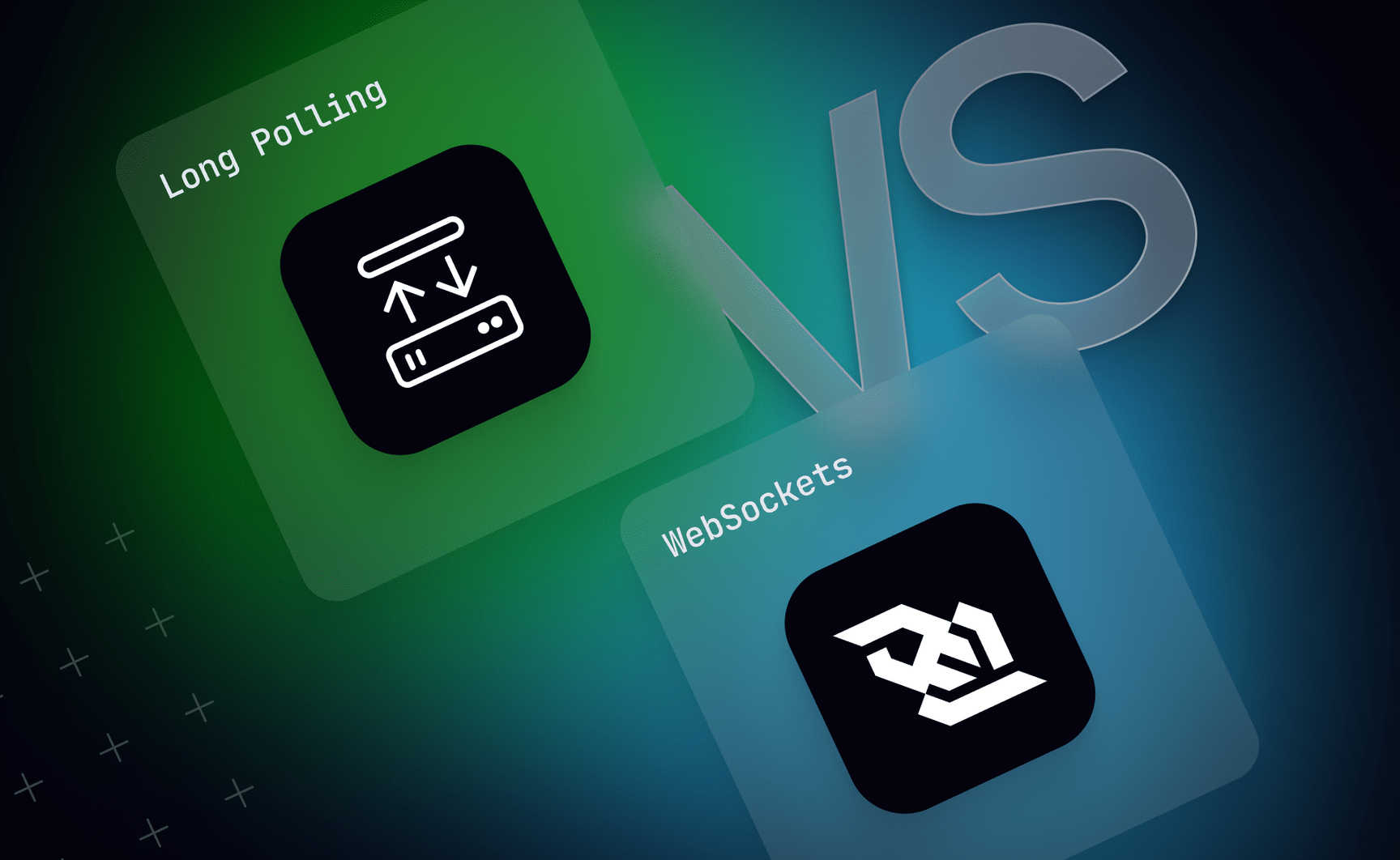Long polling and WebSockets are two common techniques for delivering realtime data. While both have been used successfully in production systems, they differ significantly in how they perform, scale, and integrate into modern architectures.
This guide compares long polling vs WebSockets to help engineering teams and technical decision-makers choose the right approach for delivering realtime experiences reliably and at scale.
What is long polling?
Long polling is a technique built on HTTP where the client makes a request to the server, and the server holds the connection open until new data is available or a timeout occurs. The client then reconnects to wait for more data, repeating the cycle.
Pros:
- Simple to implement over standard HTTP
- Compatible with most browsers and networks
- Works well in legacy systems
Cons:
- Creates overhead due to frequent reconnections
- Higher latency due to request-response cycles
- Not designed for sustained bidirectional communication
- Consumes more server resources than a WebSocket connection
- Reliable message ordering can be difficult because multiple HTTP requests can be in flight from the same client simultaneously
- Risk of missed messages since servers can mistakenly believe that the client has already received the data it is expecting.
Read more about HTTP long polling →
What are WebSockets?
WebSockets are a protocol standardized in RFC 6455 that enables full-duplex, persistent communication between a client and server over a single TCP connection. Once established, the connection remains open, allowing data to flow in both directions with minimal overhead.
Pros:
- Persistent connection enables low latency
- Efficient use of network and server resources
- Broad interoperability (browsers, servers, devices)
- Standardized protocol
- Ideal for apps requiring continuous updates (e.g. chat, IoT, gaming)
Cons:
- Manual connection handling (no automatic reconnections)
- No built-in reconnection logic or pub/sub abstraction (it's just a protocol)
- No message guarantees
- Scaling can be hard and requires additional logic
- Some legacy systems or firewalls may block WebSocket traffic
Long Polling vs WebSockets: Side-by-side comparison
| Feature | WebSockets | Long Polling |
|---|---|---|
| Communication | Full-duplex, bidirectional | Client-initiated only |
| Connection Type | Persistent | Repeated HTTP requests |
| Latency | Low | Higher due to reconnections |
| Bandwidth Usage | Efficient | Inefficient (headers, TCP overhead) |
| Server Load | Lower with optimized infra | Higher due to frequent re-establishing |
| Browser Support | Widely supported | Universally supported |
| Setup Complexity | Moderate | Simple (especially for basic use) |
| Scalability | Scales with purpose-built infra | Challenging at high connection volumes |
| Ideal Use Cases | Chat, games, dashboards, IoT | Legacy integrations, basic updates |
Performance and scalability considerations
When choosing a realtime transport, two questions often matter most:
- How fast is it?
- How well does it scale?
WebSockets: Efficient and Scalable
- Maintains a single, long-lived TCP connection
- Avoids repetitive HTTP handshakes and headers
- Reduces latency and bandwidth usage
- Ideal for high-frequency, interactive use cases (e.g. chat, gaming, IoT)
WebSocket connections are more predictable under load. With the right infrastructure, they scale horizontally and support millions of concurrent users with minimal overhead.
Long Polling: Simple but Costly at Scale
- Re-establishes a new HTTP request after each update
- Generates more network chatter and CPU load
- Higher bandwidth and server usage due to repeated handshakes
- Less efficient as user concurrency grows
In low-traffic environments, long polling may suffice. But under scale, it creates strain on your infrastructure and limits performance.
The bottom line - if you're building for performance and growth, WebSockets are a better long-term fit. They reduce operational complexity and ensure realtime interactions stay fast and efficient as you scale.
When to use each: Decision guide
Long polling may still be a viable choice when:
- You're working with legacy systems or HTTP-only environments
- Realtime updates are infrequent or low priority
- Persistent connections are blocked or unreliable
However, as user expectations for responsiveness grow, long polling is increasingly becoming a fallback rather than a first choice.
WebSockets are ideal when:
- Low latency and bidirectional communication are critical
- You need to support high message throughput or frequent updates
- You’re building features like chat, collaborative editing, live dashboards, or multiplayer games
- Scalability and efficient resource usage are required
Going beyond Long Polling and WebSocket
While WebSockets offer clear performance and scalability advantages, they’re not a silver bullet. Long polling, though simpler, has clear limitations. In some cases, neither solution fully addresses the complexity of delivering realtime experiences reliably at scale.
Common challenges include:
- Ensuring message ordering and guaranteed delivery
- Managing infrastructure for connection recovery and scaling
- Providing visibility into connection health and message flows
These gaps can become blockers as applications grow. That’s why many teams look beyond raw transport protocols to fully managed alternatives, like Ably, that offer built-in reliability, observability, and scale.
Why Ably?
Ably is a realtime platform purpose-built to overcome the limitations of both long polling and raw WebSocket implementations.
- WebSocket-native: Built on WebSockets, Ably provides a low-latency foundation for realtime messaging.
- Delivery guarantees: Ably offers message ordering, delivery confirmation, and automatic retries.
- Elastic scaling: Handles millions of concurrent connections globally with autoscaling infrastructure.
- Protocol interoperability: Supports WebSockets, MQTT, SSE, and proprietary protocols via adapters.
- Operational resilience: Ably delivers 99.999% uptime SLA and handles connection recovery, failover, and global distribution.
- Observability: Built-in diagnostics, message history, and usage analytics.
With Ably, you get the performance of WebSockets without the complexity of managing realtime infrastructure yourself.
Next steps:




